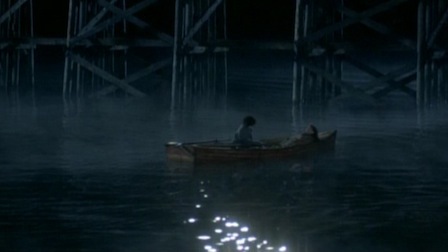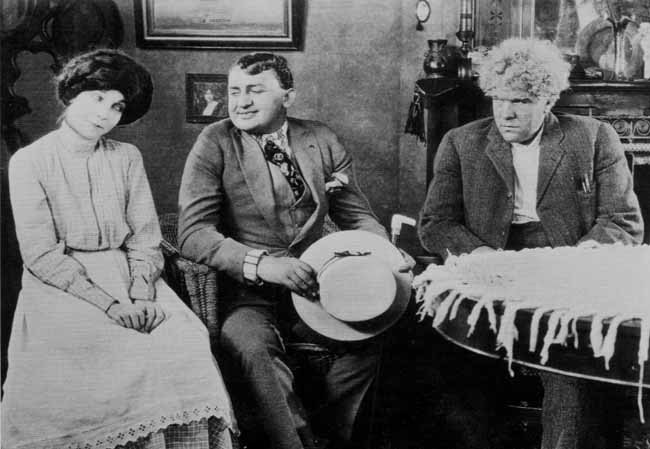This was originally published in the January 22, 1988 issue of the Chicago Reader. — J.R.
HOUSEKEEPING **** (Masterpiece)
Directed and written by Bill Forsyth
With Christine Lahti, Sara Walker, Andrea Burchill, Anne Pitoniak, Margot Pinvidic, and Bill Smillie.
Two or three days and nights went by; I reckon I might say they swum by, they slid along so quiet and smooth and lovely. — The Adventures of Huckleberry Finn
Marilynne Robinson’s novel Housekeeping is virtually defined by its slow, swirling rhythms, but one of the first things that is apparent about Bill Forsyth’s passionate, faithful film adaptation is that, as story telling, it starts out with a hop, skip, and jump; and although an idea of leisurely pacing is sustained throughout, the movie never dawdles, stalls, or grinds to a halt. Like the magical opening of Terrence Malick’s 1973 Badlands and the no less incandescent ending of his 1978 Days of Heaven –- two more films in which the heroine’s offscreen narration plays a musical role in the narrative structure -– the story unfolds with the combined immediacy and remoteness of a fairy tale. An elliptical stream of details and events spanning three generations flows by in minutes, without imparting any feeling of haste.
For fans of Bill Forsyth, who has become something of a directorial brand name, the effect may be more than a little disconcerting. My own spotty sense of Forsyth’s previous work — mainly restricted to having seen Gregory’s Girl (1980) many years ago –- hadn’t led me to expect a film with this sort of ambition or depth. A lowercase filmmaker in the sense that e.e. cummings is a lowercase poet, Forsyth is a master of the small point, the sidelong glance, and the quirky off moment. Perhaps by associating Gregory’s Girl with the behavioral charm of a Francois Truffaut or a Milos Forman, I was misled into assuming that the Scottish filmmaker wasn’t above milking his audience with a related form of humanist hype, effective but rather facile; now I’m inclined to suspect that he may be a good deal more subtle than either.
The story is about two sisters, Ruthie (Sara Walker, the narrator) and Lucille (Andrea Burchill) Foster, who, after an early childhood in Seattle and the early departure of their father, are raised in the small town of Fingerbone –-a lakeside community in the mountains of the Pacific northwest — by a succession of women. After their mother Helen (Margot Pinvidic) drops them at the family homestead before driving off a cliff and drowning in the lake, for mysterious reasons that are never discussed, they are raised first by their grandmother; then, after she dies, by two great-aunts; and finally by Helen’s itinerant and eccentric younger sister Sylvie (Christine Lahti), who returns to Fingerbone to assume this job.

Although the sisters are very close and mutually isolated from the community, the weirdness of their even more isolated aunt and her impact on the town eventually drive them apart, and Lucille goes to live with her home-economics teacher. After Sylvie takes Ruth on an excursion by boat to a frost-covered valley, and they wind up staying out all night and returning home by hopping a freight car, the sheriff and various local women begin to question Sylvie’s suitability as a guardian. When a hearing is scheduled, Sylvie and Ruth burn their house down and set out for a life on the road.
This is more or less the plot of the film, although it omits a major incident in the memory of the family and the town that hovers over the entire action and setting like a gigantic phantom. The girls’ grandfather — who grew up in the flat plains of the midwest, dreaming of and painting mountains -– married and settled in Fingerbone, working for the railroad. Returning home one night from Spokane, his train derailed on the bridge and sank into the lake without leaving a trace; none of the 200 passengers were ever recovered. As reminders and sole witnesses of this tragedy, the elevated train tracks, mountains, and lake might be said to function in the story as characters equal in importance to the Fosters.
Two hauntingly beautiful shots of these train tracks frame the main body of the narrative, from the grandmother’s death to the final departure of Ruth and Sylvie. In the first and briefer of these, the mountains, lake, and an approaching train might be considered the scene’s major protagonists, although the tiny figures of the young sisters and their grandmother are also visible at the base of the embankment. In the second, only the tracks are visible, glowing luminously at night, and this semiabstract image is held on the screen for an extended length of time.
As fictional material, Robinson’s novel is at times closer to reverie and landscape painting than to straight narrative, and part of Forsyth’s remarkable achievement is to have captured much of this mood without impeding the narrative flow. A certain parallel to the book and film can be found in elements from Huckleberry Finn and its own reflections on the conditions and meaning of freedom, with orphaned Ruth standing in for Huck, Sylvie as a counterpart to Jim –- her onetime marriage and her escape from it give her some of the status of an “escaped slave” -– and Lucille’s hankering after middle-class acceptance and respectability putting her roughly in Tom Sawyer’s camp. Admittedly, these parallels are loose and approximate, but the all-male world of Mark Twain’s novel and the all-female world of Robinson’s account for some of the differences, while the relationship between black struggle and feminist struggle serves to elucidate others.
Film adaptations of literary works can be compared in certain ways to translations from one language to another; both require, I think, a technique that bears a resemblance to Method acting, a manner of working inside rather than outside the material. While it’s often thought that the best translation of a text is literal and word-for-word, professional translators know that such a model is generally unworkable because of the idioms involved. To take a crude example, the French term baise anglaise means literally “English kiss,” but signifies the same thing that we and the English mean by “French kiss”; a more complex example would point up the syntactical differences between French and English, such as the fact that all French nouns have masculine or feminine genders.
The syntactical differences between prose and film are a good deal more complex, and it is naive to assume that the best film adaptations of novels can provide precise equivalents to each of the elements in the originals. While one can plausibly cite Stroheim’s Greed as a model film adaptation, the common assumption that Stroheim made it by filming Frank Norris’s McTeague “page by page, never missing a paragraph” –- as Kenneth Rexroth puts it in the Signet edition -– couldn’t be further from the truth. In fact, Stroheim got so far inside the spirit and texture of the original that, like any good Method actor, he was able to generate his own material out of it: almost the first fifth of the published script of Greed, nearly 60 pages, describes incidents invented by Stroheim that occur prior to the action at the beginning of the novel.
Forsyth’s adaptation of Housekeeping is much closer to Stroheim’s method than it is to the more literal –- hence reductive — approach taken by adapters ranging from Joseph Strick to John Huston. (It is true that Tony Huston’s script for The Dead is at least bold enough to add a character to Joyce’s story; but on the whole Huston père followed a route of faithful reduction rather than one of empathetic embellishment.) This is not merely a matter of rearranging the exposition –- so that, for instance, the account of the train plunging to the bottom of the lake occurs in detail much later in the film than in the novel, figuring as a flashback –- or ending the story many years and pages before the novel does, but also of adding new details and lines of dialogue that are improvisations on elements found in the original.
The film’s treatment of Helen and her suicide are characteristic of this inventiveness. While driving into downtown Fingerbone with her daughters early in the morning, she stops at a green light, pauses, and then charges ahead when it changes to red. (Forsyth frames this gag in a Tatiesque long shot, and, again like Tati, waits patiently for it to happen -– a small addition, but one that deftly anticipates the quirkiness of Sylvie.) Prior to her suicide, she parks her car in a field and gets stuck in the mud. As in the novel, a group of boys offer her a hand and she gives them her purse in return; Forsyth’s embellishment is to have her insist that they put her own jacket and overcoat under a rear wheel before they push the car — another small detail that speaks volumes. When, moments later, she sails over a cliff into the lake, Forsyth’s depiction of the event, restricted to the boys’ viewpoint, is as elliptical as the suicide in Bresson’s Une femme douce; we see only the bubbles rising to the lake’s surface. And because the account of the train disaster occurs shortly after this, the mysteriousness of the plunge both prepares us for it and subtly suggests -– as Robinson does in other ways -– that Helen’s suicide was probably inspired in part by her father’s demise.
A slippery character in book and film alike, Sylvie projects a combined serenity and distractedness that makes her antisocial and emotionally sealed off in a friendly way, and blissfully daffy without ever losing her basic grip on reality. (One of her favorite activities is sitting alone in the dark.) It’s alarming to hear that Diane Keaton was originally cast in the role, and backed out of it only at the last moment –- not because she lacks the talent to play such a character, but because it is almost impossible to imagine her not doing a star turn with the part. Although Christine Lahti, her inspired replacement, has already been criticized in some quarters for not being more of a show-off as Sylvie, it’s clear that any grandstanding could shatter the delicate textures that Forsyth carefully builds around her. One of her loveliest speeches, about the train accident -– ”The lake must be full of people. I’ve heard stories all my life. You can bet there were a lot of people on the train nobody knew about” –- could be crushed by anything but an offhand delivery, and Lahti makes it sweetly sing.
Indeed, Lahti seems so buried in the character’s inwardness that she becomes the perfect instrument for the kind of grace notes that Forsyth’s style abounds in. When Fingerbone becomes flooded and the sisters come downstairs one morning to encounter their aunt casually greeting them with a coffee cup while trudging around in several inches of muddy water, Keaton, one imagines, would likely have given the moment a Neil Simon inflection. Lahti’s consummate professionalism — all the more impressive in her seamless interplay with the Vancouver nonprofessionals who play Ruthie and Lucille — is to blend her throaty Paula Prentiss voice, dopey smile, and spiky movements with the film’s overall low-key temperature, resulting in some of the best naturalistic acting to be found anywhere at the moment. It is the kind of nonegotistical performance, moreover, that allows her to fit in a period context without any hint of anachronism — a virtue she already displayed as Goldie Hawn’s next-door neighbor in Swing Shift, and which Keaton conspicuously lacked as Louise Bryant in Reds.
It is a sensitivity that Lahti shares with Forsyth and his largely Scottish crew in getting the early 50s just right without trumpeting the fact -– although a director friend points out that the film does fudge Lahti’s makeup in relation to the period on a few occasions. Some of the movie’s finer inventions –- Sylvie laughing at a hokey refrigerator ad with a smiling couple in a shop window, Lucille and Ruthie softly singing “Oh My Papa” while smoking grapevine on a leafy hillside, and an impeccably imagined red vinyl soda shop where “Sh-boom” is purring on the jukebox -– come from this unobtrusive perfection, which extends to its gorgeous use of the local scenery. (The film was shot in Nelson, British Columbia, which was also used in Roxanne.) A period song mentioned in the novel, “Irene,” is utilized as well, but elaborated upon so effectively, in separate scenes with Helen and Sylvie, that the film intensifies its meaning.
Although the early 50s is a period we usually associate with affluence and stolidity (unless we think of On the Road), part of the film’s mysterious beauty relates to the lives of the wandering and the homeless that we more readily associate with the 30s — the grim yet lyrical world of Nelson Algren’s Somebody in Boots, which has more than anecdotal relevance to the world of the homeless today. (The hoboes often passed by Sylvie, Ruth, and Lucille near the lake and railroad tracks are mainly ignored by the characters and plot, but their presence is frequently felt, and remarked on twice in Ruth’s narration.)

The discomfort that some spectators may feel about Sylvie, which may lead some of them to dismiss her as a “bag lady” — a comfortable, reassuring epithet for anyone unwilling to consider too closely her current, real-life counterparts–points to the degree to which non-Americans may be privy to certain insights about this country that we’re too shielded to see for ourselves. After a second look at Housekeeping, I wouldn’t call it a great film, but it comes very close to being a perfect one in everything that it sets out to do. Which is only to say that it may have taken a Scotsman to show us the contemporary importance, the depths and radiance, of Robinson’s novel.





